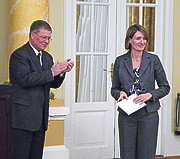Home > Press > MIC Professor Anja Boisen awarded for sensor technology research
 |
Abstract:
Professor Anja Boisen was awarded for her groundbreaking sensor technology research. The professor in Micro and Nanotechnology from MIC received the prize of 250.000 Danish Kroner from Direktør Ib Henriksen's Fund at a reception at Hotel D'Angleterre in Copenhagen.
MIC Professor Anja Boisen awarded for sensor technology research
COPENHAGEN, DENMARK | Posted on December 10th, 2007The prize was given to Anja Boisen explicitly for her efforts in developing micro and nano sensors capable of detecting explosives, bacteria in foods, and nanoparticles in work environments.
The research award was handed out for the 22nd time, at a ceremony on 10th of December 2007. Anja Boisen's focused work on making advanced nanotechnology research beneficial for society, was stated as the main reason for the award by fund chairman Michael Prince. Also the fund had taken particular notice of Anja Boisen's international reputation and virtue of attracting international research co-operation and visitors to Denmark.
The research award is given on recommendation from an expert committee consisting of Professor Klaus Bock, chairman of The Danish National Research Foundation, and Søren Isaksen, CTO at NKT. Søren Isaksen elaborated on the reasons for giving the award to Anja Boisen: "You are known and recognized for letting your young colleagues step forward and show the results, that you have jointly produced." He ended his speech congratuling Anja Boisen on her remarkable scientific achievements.
Professor Anja Boisen is head of the NanoSystems Engineering-section at MIC - Department of Micro and Nanotechnology at the Technical University of Denmark (DTU). With her research group, nanoprobes, she has amongst other things developed disposable sensors in plastic, built complicated electronics into small instruments, and produced simple colour changing sensors that alert consumers on high bacteria levels in food.
A microsensor is about the width of a human hair, while a nanosensor is about a thousand times smaller. Sensors are used to 'sense' the surroundings. Advanced nanosensor technology has an extensive range of potential uses in ie. industrial production, foods, biomedicine, environmental control and anti-terrorism devices. The scientific work of Anja Boisen, known to be at the forefront of international research, has led to significant advances in sensor technology development.
The experiences from Anja's succesful career are put to use in her daily work with her research group. One of the projects they are working on, in collaboration with both university and industrial partners, is the NanoNose. The scope of the NanoNose program is to develop a gas sensor - or an "artificial nose" based on polymer cantilever arrays and an optical detection system. The principle is that molecules adsorbed on a micrometer-sized cantilever will cause the cantilever to deflect due to changes in surface stress. Alternatively, a mass change can be detected by monitoring a shift in the resonant frequency of the cantilever. For mass detection the cantilever should be as small as possible (nanometer dimensions) in order to increase the mass sensitivity. The artificial nose will be capable of accurately recognizing and quantifying a number of different airborne chemical entities present at extremely low concentrations simultaneously.
####
About University of Denmark
MIC is a centre of excellence in micro- and nanotechnology at the Technical University of Denmark (DTU). MIC was established as an autonomous research centre for microelectronics in 1991. In 2003, MIC joined the DTU as the Department of Micro- and Nanotechnology. The original mission for MIC was to establish a microelectronics industry in Denmark through close collaboration with Danish industry. Shortly after establishment of the centre research activities widened to broader aspects of microtechnology. In the past decade, MIC has made major contributions to the development of process technology that has allowed fabrication of a wide range of functional components. Traditionally at MIC such components contained micromechanical parts for the conversion of mechanical movements to electronic signals, and vice versa. In recent years, MIC has been heading towards applications of micro- and nanotechnology in the life sciences. Our present portfolio of scientific strengths comprises simulation and fabrication, laboratory-on-chip technology, sensor technology, and micro- and nanoscale theory.
For more information, please click here
Contacts:
Jesper Spang
Copyright © University of Denmark
If you have a comment, please Contact us.Issuers of news releases, not 7th Wave, Inc. or Nanotechnology Now, are solely responsible for the accuracy of the content.
| Related News Press |
Sensors
Announcements
![]() NRL charters Navy’s quantum inertial navigation path to reduce drift April 5th, 2024
NRL charters Navy’s quantum inertial navigation path to reduce drift April 5th, 2024
![]() Discovery points path to flash-like memory for storing qubits: Rice find could hasten development of nonvolatile quantum memory April 5th, 2024
Discovery points path to flash-like memory for storing qubits: Rice find could hasten development of nonvolatile quantum memory April 5th, 2024
Grants/Sponsored Research/Awards/Scholarships/Gifts/Contests/Honors/Records
![]() Discovery points path to flash-like memory for storing qubits: Rice find could hasten development of nonvolatile quantum memory April 5th, 2024
Discovery points path to flash-like memory for storing qubits: Rice find could hasten development of nonvolatile quantum memory April 5th, 2024
![]() Chemical reactions can scramble quantum information as well as black holes April 5th, 2024
Chemical reactions can scramble quantum information as well as black holes April 5th, 2024
|
|
||
|
|
||
| The latest news from around the world, FREE | ||
|
|
||
|
|
||
| Premium Products | ||
|
|
||
|
Only the news you want to read!
Learn More |
||
|
|
||
|
Full-service, expert consulting
Learn More |
||
|
|
||








